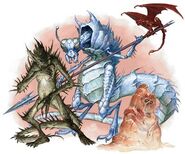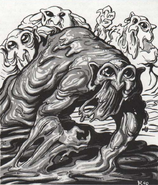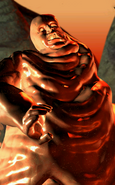Lemures (pronounced: /lɛmˈjʊərz/ lem-YOORZ[7] or: /lɛmˈjɔːrz/ lem-YORZ[7] or: /ˈlimjɜːrz/ LEEM-yurz[8]), also called squidges in infernal slang,[9] were among the weakest of the baatezu devils. They served as the shock troops and slave labor force of the devils, and were made from the wicked, cruel, and selfish mortals that found their souls in Hell.[1][6][10]
Classifed as least devils by some scholars[11][12][13] but not even worthy of classification by most others,[8][11][14][15][16] lemures were at the bottom of the infernal hierarchy, sitting just below the bloated nupperibos.[11][12][8][14][13]
Description[]
Lemures were hideous, 5 ft (1.5 m) tall blobs of molten, stinking flesh that oozed across the ground as they moved.[10][6] They were a formless, shivering, 100 lb (45 kg) mass below their waists but their heads and torsos were of a vaguely humanoid shape.[6][18] Even as their facial features melted and shifted they maintained a permanent expression of horror and anguish, with most constantly gibbering to themselves despite their inability to speak.[4][1]
Hints of mortal's former self could be seen in a lemure when they were not too twisted in anguish.[19] Although most were unrecognizable, a rare lemure showed some memory of their mortal life by occasionally making certain facial features or nervous twitches. Even if not made through expressions, some had vestiges of their past lives, such as small shreds of clothing still attached to their amorphous masses.[4] Over time, however, remnants of individuality would become less noticeable as they continued to endure their wretched existences.[20]
Behavior[]
Lemures were almost completely mindless and effectively incapable of making decisions, even those that concerned themselves.[21] They existed in a state of constant physical pain[18] and sought revenge against reality itself as they blamed all the cosmos for their current condition, violently lashing out at all beings.[6] Only the forced, telepathic mandates of their superiors was able to restrain their thirst for vengeance, for lemures were sensitive to such messages, unquestioningly obeying the strongest devil nearby.[6][22] They generally tried to avoid other devils and rampaged in their hordes.[4]
No matter from what kind of soul a given lemure was created, they normally retained nothing of their old personality or memory, although rarely a minor remnant of their memories would still be present. Unless directed, they behaved as if they had been feebleminded.[22] However, despite their mindlessness, they were capable of a primary motivation for promotion and the innate understanding that this would occur if they somehow proved themselves.[18][4]
Abilities[]
Lemures were hard to kill as they had an inherent and tenuous, if slow, regeneration ability. Even if turned into ash, they could fully regenerate over time. One way to permanently kill them was to use holy implements such as a holy weapon or holy water.[3] Another method was to eat them, the tactic that was both the most secure and most commonly used by demons.[23] Lemures had a complete immunity against any effects that attempted to tamper with their minds, due to not having minds to manipulate.[6]
Combat[]
Lemures shambled forward in infernal legions at the command of their masters' telepathy, thoughtlessly slaughtering everything in their path and stopping only at the telepathic commands of their superiors.[6] They usually attacked their prey by clawing them apart or beating them into submission. They were individually weak and their tactics, or what passed as such, consisted of swarming their enemies and relying on their numbers, although they didn't always need great numbers to succeed.[3][1]
Said numbers could reach more than a thousand under a single devil commander, allowing them to march in a special wedge formation called a "battle drive", which allowed them to hit more accurately.[3][1] The slowly crawling horde often, eventually, prevailed by virtue of sheer numbers, but commonly saw a 70-90% casualty rate, so the tactic was typically reserved for desperate battles when success was more important than the army's own longevity.[20]
Society[]
Lemures were the lowest of the baatezu, despised by other devils, regularly abused and lacking a true name.[3][1][22][25] They served the most base duties in any infernal group[19] and were marshaled en masse by spinagons and amnizus into the infernal armies that were thrown into the Blood War,[3][1][22][25][26] acting as fodder to draw enemy fire in any initial confrontation.[19]
When not engaged in battle, lemures were left in the fiery spawning pits of Hell to torture any mortal souls that they found swimming amid the hellfire.[4] Lemures were suspected to be of infinite numbers and often wandered Avernus and Dis in massive hordes.[21][20]
Promotion[]
It was presumed that the mindlessness of the lemures was by design so that the baatezu could easily influence the lower caste into choosing the path of evil. With this mindlessness came the lack of a "lesson" that the lemure needed to learn if it wanted a promotion.[21] Souls that arrived in the Nine Hells in the form of lemures, driven only by their desire to do evil, had the many rules of Baator driven into what passed for their minds by patrolling amnizu.[26]
As low as a lemure's position was, they had a shot at a high position in the infernal hierarchy as any lemure was at least theoretically capable of rising through the ranks up to pit fiend rank and from there to higher nobility.[3] After becoming a lemure, the baatezu acknowledged the creature as part of their race and not as a petitioner, although they were still beneath notice.[21] They had not even truly begun the process of having their spirits expunged of the taint of chaos (and maybe even good).[27]
The process was mostly randomized, however, based on the need of the promoter rather than the merit of the lemure, although occasionally such a process was used for amusement. When a lemure had the chance to be promoted to a spinagon, it sometimes had to fight against other lemures up for the position. After one won, its skin was taken away to reveal the form of a spinagon. It was also entirely possible the devil in charge of the fight would simply kill the winner if the fight failed to be entertaining.[18][4][28]
Promotion at such a low level was something that could be done by a greater devil and was done when there was some demand for a specialized skill, such as the common transformation into an imp, or strangely into a wraith or spectre.[1][4] Conversely, it was entirely possible for a higher-ranking baatezu to commit such a severe crime that it was demoted to lemure status, causing them to lose all their memories.[1][28]
Ecology[]
Generally speaking, only the most vile of mortal souls could achieve lemure status.[19] When a soul arrived in Baator, they were shipped to torture stations and underwent a process of unimaginable agony, wracking their souls with pain, infusing them with fury and wringing them out of all their energy.[18][1] This often involved the use of a bed-like torture device known as a shriver that rended energy from mortal souls,[29] as well as the work of kyton and excruciarch teams to turn their petitioner victims into proto-lemures. Once completely drained of energy, the souls underwent arcane rituals that corrupted them with infernal power.[1][18] The process of lemure creation was concluded with dropping the proto-lemure into the Maggot Pit in Avernus, whereupon the drained husk would swiftly die before being reborn as a lemure.[18]
They could also be made from soul larvae, although, out of about a hundred thousand, only about a dozen were turned by the devils into lemures after a natural selection process. It was also possible for lemures to be made through demoting the nupperibos that naturally appeared from soul larvae. Occasionally, lemures even spontaneously pulled themselves from Baator itself although such an event was rare.[21] Souls without contracts in place with devils beforehand, having landed themselves in the Nine Hells through their own lawful evil behavior, often emerge from the River Styx.[30]
If a lemure did not manage to get a promotion, something that was effectively a matter of chance at their low station, it was over time absorbed into Baator like the petitioners they truly were.[18][4][28]
Lemures needed more frequent but shorter rests than higher-ranking devils, stopping whenever they could to satisfy the five minutes they needed to be fully recovered. They were genderless devils that had no sex organs.[23]
Appendix[]
See Also[]
Appearances[]
Adventures
Novels & Short Stories
Masquerades
Comics
Video Games
Baldur's Gate III
Card Games
Miniatures
Organized Play & Licensed Adventures
Gallery[]
References[]
- ↑ 1.00 1.01 1.02 1.03 1.04 1.05 1.06 1.07 1.08 1.09 1.10 1.11 1.12 Mike Mearls, Jeremy Crawford, Christopher Perkins (2014-09-30). Monster Manual 5th edition. Edited by Scott Fitzgerald Gray. (Wizards of the Coast), pp. 67, 69, 76. ISBN 978-0786965614.
- ↑ Skip Williams, Jonathan Tweet, Monte Cook (July 2003). Monster Manual v.3.5. (Wizards of the Coast), p. 57. ISBN 0-7869-2893-X.
- ↑ 3.0 3.1 3.2 3.3 3.4 3.5 3.6 3.7 Chris Pramas (November 1999). Guide to Hell. Edited by Kim Mohan. (TSR, Inc.), pp. 46, 59. ISBN 978-0786914319.
- ↑ 4.00 4.01 4.02 4.03 4.04 4.05 4.06 4.07 4.08 4.09 4.10 4.11 4.12 J. Paul LaFountain (1991). Monstrous Compendium: Outer Planes Appendix. Edited by Timothy B. Brown. (TSR, Inc.), p. 23. ISBN 1-56076-055-9.
- ↑ Gary Gygax (December 1977). Monster Manual, 1st edition. (TSR, Inc), p. 23. ISBN 0-935696-00-8.
- ↑ 6.0 6.1 6.2 6.3 6.4 6.5 6.6 6.7 Skip Williams, Jonathan Tweet, Monte Cook (July 2003). Monster Manual v.3.5. (Wizards of the Coast), p. 57. ISBN 0-7869-2893-X.
- ↑ 7.0 7.1 Frank Mentzer (January 1985). “Ay pronunseeAYshun gyd”. In Kim Mohan ed. Dragon #93 (TSR, Inc.), p. 28.
- ↑ 8.0 8.1 8.2 J. Paul LaFountain (1991). Monstrous Compendium: Outer Planes Appendix. Edited by Timothy B. Brown. (TSR, Inc.). ISBN 1-56076-055-9.
- ↑ Robin D. Laws, Robert J. Schwalb (December 2006). Fiendish Codex II: Tyrants of the Nine Hells. Edited by Chris Thomasson, Gary Sarli, Penny Williams. (Wizards of the Coast), p. 68. ISBN 978-0-7869-3940-4.
- ↑ 10.0 10.1 Sean K Reynolds (2002-05-27). Hell in the Forgotten Realms. Wizards of the Coast. Archived from the original on 2003-06-18.
- ↑ 11.0 11.1 11.2 Colin McComb (September 1997). Faces of Evil: The Fiends. Edited by Ray Vallese. (Wizards of the Coast), p. 13. ISBN 0-7869-3430-1.
- ↑ 12.0 12.1 Robin D. Laws, Robert J. Schwalb (December 2006). Fiendish Codex II: Tyrants of the Nine Hells. Edited by Chris Thomasson, Gary Sarli, Penny Williams. (Wizards of the Coast), p. 10. ISBN 978-0-7869-3940-4.
- ↑ 13.0 13.1 Adam Lee, et al. (September 2019). Baldur's Gate: Descent into Avernus. Edited by Michele Carter, et al. (Wizards of the Coast), p. 212. ISBN 978-0-7869-6687-5.
- ↑ 14.0 14.1 "The Hierarchy of Baator" poster included in Colin McComb and Wolfgang Baur (February 1995). Planes of Law. (TSR, Inc.). ISBN 0-7869-0093-8.
- ↑ Mike Mearls, Jeremy Crawford, Christopher Perkins (2014-09-30). Monster Manual 5th edition. Edited by Scott Fitzgerald Gray. (Wizards of the Coast), p. 67. ISBN 978-0786965614.
- ↑ Mike Mearls, Jeremy Crawford (May 29, 2018). Mordenkainen's Tome of Foes. Edited by Kim Mohan, Michele Carter. (Wizards of the Coast), p. 17. ISBN 978-0786966240.
- ↑ Jim Zub (December 2019). “Infernal Tides 1”. Infernal Tides #1 (IDW Publishing) (1)., p. 1.
- ↑ 18.0 18.1 18.2 18.3 18.4 18.5 18.6 18.7 Robin D. Laws, Robert J. Schwalb (December 2006). Fiendish Codex II: Tyrants of the Nine Hells. Edited by Chris Thomasson, Gary Sarli, Penny Williams. (Wizards of the Coast), pp. 8–9. ISBN 978-0-7869-3940-4.
- ↑ 19.0 19.1 19.2 19.3 Jeff Grubb, Bruce R. Cordell, David Noonan (September 2001). Manual of the Planes 3rd edition. (Wizards of the Coast), pp. 115–116. ISBN 0-7869-1850-8.
- ↑ 20.0 20.1 20.2 Allen Varney, ed. (June 1994). Planescape Monstrous Compendium Appendix. (TSR, Inc.), p. 25. ISBN 978-1560768623.
- ↑ 21.0 21.1 21.2 21.3 21.4 Colin McComb (September 1997). Faces of Evil: The Fiends. Edited by Ray Vallese. (Wizards of the Coast), pp. 12–13. ISBN 0-7869-3430-1.
- ↑ 22.0 22.1 22.2 22.3 Richard Baker, James Wyatt (March 2004). Player's Guide to Faerûn. (Wizards of the Coast), p. 161. ISBN 0-7869-3134-5.
- ↑ 23.0 23.1 Colin McComb (September 1997). Faces of Evil: The Fiends. Edited by Ray Vallese. (Wizards of the Coast), pp. 20–21, 24. ISBN 0-7869-3430-1.
- ↑ Colin McComb (September 1997). Faces of Evil: The Fiends. Edited by Ray Vallese. (Wizards of the Coast), p. 13. ISBN 0-7869-3430-1.
- ↑ 25.0 25.1 J. Paul LaFountain (1991). Monstrous Compendium: Outer Planes Appendix. Edited by Timothy B. Brown. (TSR, Inc.), p. 29. ISBN 1-56076-055-9.
- ↑ 26.0 26.1 Mike Mearls, Jeremy Crawford (May 29, 2018). Mordenkainen's Tome of Foes. Edited by Kim Mohan, Michele Carter. (Wizards of the Coast), p. 164. ISBN 978-0786966240.
- ↑ Colin McComb (September 1997). Faces of Evil: The Fiends. Edited by Ray Vallese. (Wizards of the Coast), p. 32. ISBN 0-7869-3430-1.
- ↑ 28.0 28.1 28.2 Colin McComb (September 1997). Faces of Evil: The Fiends. Edited by Ray Vallese. (Wizards of the Coast), pp. 17–18. ISBN 0-7869-3430-1.
- ↑ Robin D. Laws, Robert J. Schwalb (December 2006). Fiendish Codex II: Tyrants of the Nine Hells. Edited by Chris Thomasson, Gary Sarli, Penny Williams. (Wizards of the Coast), p. 52. ISBN 978-0-7869-3940-4.
- ↑ Mike Mearls, Jeremy Crawford (May 29, 2018). Mordenkainen's Tome of Foes. Edited by Kim Mohan, Michele Carter. (Wizards of the Coast), p. 12. ISBN 978-0786966240.
Connections[]
Least: Lemure • Nupperibo • Spinagon
Lesser: Abishai (Black • Blue • Green • Red • White) • Barbazu • Bueroza • Erinyes • Excruciarch • Falxugon • Ghargatula • Hamatula (Stony devil) • Kocrachon • Merregon • Osyluth • War devil • Xerfilstyx
Greater: Amnizu • Brachina • Cornugon • Gelugon • Logokron • Narzugon • Orthon • Paeliryon • Pit fiend
Baatezu of unknown rank: Advespa • Ayperobos • Dogai • Gulthir • Jerul • Remmanon
Araton • Brazen devil • Burning devil • Fimbrul devil • Gorechain devil • Hellcat • Hellforged devil (Coal • Glass • Lead • Obsidian • Sand • Spiked) • Hellwasp • Imp (Assassin • Bloodbag • Book • Euphoric • Filth • Gilded) • Indwelling devil • Infernal armor animus • Kalabon • Kyton • Misfortune devil • Passion devil • Pillager devil • Seared devil • Shocktroop devil • Slime devil • Soulrider devil • Stitched devil • Storm devil • Swarm devil • Succubus • Tar devil • Vizier devil • Withering devil • Warder devil • Wrath devil



